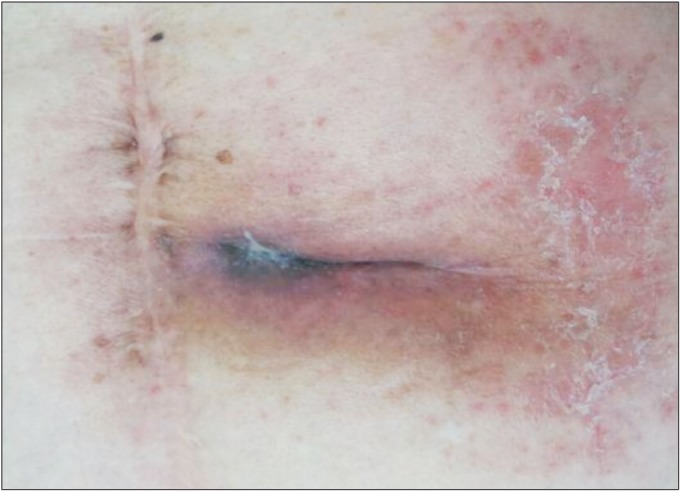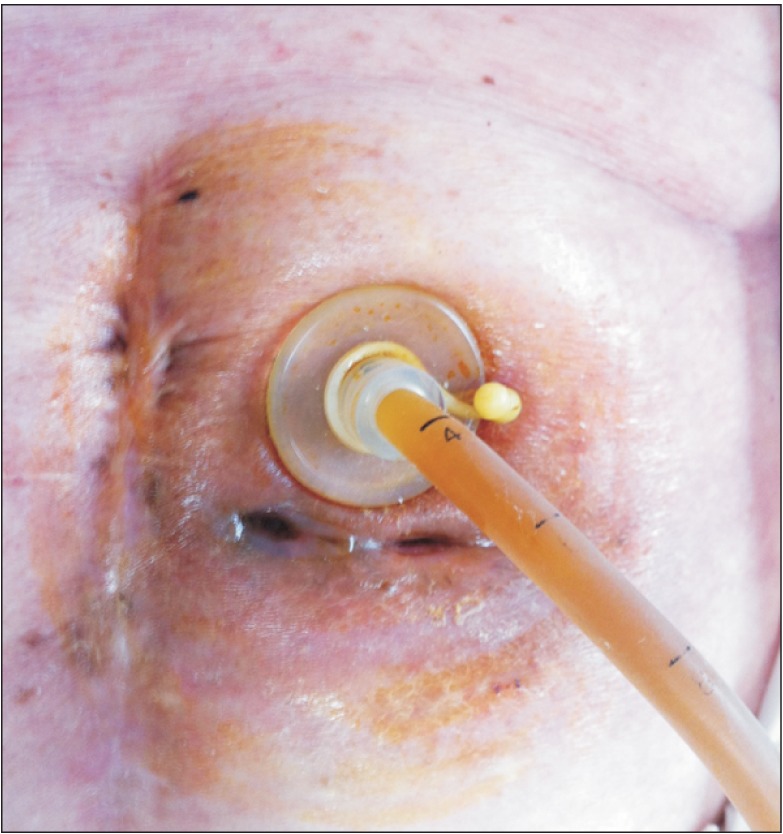Ann Rehabil Med.
2015 Feb;39(1):133-137. 10.5535/arm.2015.39.1.133.
Conversion of Percutaneous Endoscopic Gastrostomy to Gastrojejunostomy Under Fluoroscopic Guidance for Treatment of Gastrocutaneous Fistula
- Affiliations
-
- 1Department of Rehabilitation Medicine, St. Vincent's Hospital, The Catholic University of Korea College of Medicine, Suwon, Korea. joychan85@hotmail.com
- 2Department of Radiology, St. Vincent's Hospital, The Catholic University of Korea College of Medicine, Suwon, Korea.
- KMID: 2273030
- DOI: http://doi.org/10.5535/arm.2015.39.1.133
Abstract
- Persistent enterocutaneous fistula after the removal of a gastrostomy tube is an unusual complication of percutaneous endoscopic gastrostomy (PEG). The following case report describes an 81-year-old man diagnosed with stroke and dysphagia in May 2008. The patient had been using a PEG since 2008, and PEG site infection occurred in June 2013. The PEG tube was removed and a new PEG tube was inserted. Thereafter, formation of gastrocutaneous fistula around the previous infected PEG site was observed. The fistula was refractory to medical management, accompanied by long duration of fasting and peripheral alimentation. Therefore, gastrojejunostomy tube insertion via the previously inserted PEG tube was performed, under fluoroscopic guidance; this mode of management was successful. For patients who have a gastrocutaneous fistula, gastrojejunostomy tube insertion via the pre-existing PEG tube is a safe and effective alternative management for enteral feeding.
Keyword
MeSH Terms
Figure
Reference
-
1. James A, Kapur K, Hawthorne AB. Long-term outcome of percutaneous endoscopic gastrostomy feeding in patients with dysphagic stroke. Age Ageing. 1998; 27:671–676. PMID: 10408659.
Article2. Choi IT, Chae SI, Song JH, Kim YJ, Nah YH. Percutaneous endoscopic gastrostomy. Korean J Gastroenterol. 1986; 18:77–83.3. Ponsky JL. Percutaneous endoscopic gastrostomy and jejunostomy: endoscopic highlights. Gastrointest Endosc. 1984; 30:306–307. PMID: 6489716.
Article4. Shin KH, Shin JH, Song HY, Yang ZQ, Kim JH, Kim KR. Primary and conversion percutaneous gastrojejunostomy under fluoroscopic guidance: 10 years of experience. Clin Imaging. 2008; 32:274–279. PMID: 18603182.
Article5. Peter S, Geyer M, Beglinger C. Persistent gastrocutaneous fistula after percutaneous gastrostomy tube removal. Endoscopy. 2006; 38:539–540. PMID: 16767596.
Article6. Makris J, Sheiman RG. Percutaneous treatment of a gastrocutaneous fistula after gastrostomy tube removal. J Vasc Interv Radiol. 2002; 13(2 Pt 1):205–207. PMID: 11830628.
Article7. El-Rifai N, Michaud L, Mention K, Guimber D, Caldari D, Turck D, et al. Persistence of gastrocutaneous fistula after removal of gastrostomy tubes in children: prevalence and associated factors. Endoscopy. 2004; 36:700–704. PMID: 15280975.
Article8. Akhras J, Tobi M, Zagnoon A. Endoscopic fibrin sealant injection with application of hemostatic clips: a novel method of closing a refractory gastrocutaneous fistula. Dig Dis Sci. 2005; 50:1872–1874. PMID: 16187189.
Article
- Full Text Links
- Actions
-
Cited
- CITED
-
- Close
- Share
- Similar articles
-
- A Nasogastric Tube Inserted into the Gastrocutaneous Fistula
- Successful management of a chronic post-surgical gastrocutaneous fistula using as a route for enteral feeding tube placement: A case report
- Updates on Percutaneous Radiologic Gastrostomy/Gastrojejunostomy and Jejunostomy
- Endoscopic hemostasis using an over-the-scope clip for massive bleeding after percutaneous endoscopic gastrostomy removal: a case report
- Percutaneous Endoscopic Gastrostomy Through the Sinus Tract of a Surgical Gastrostomy






